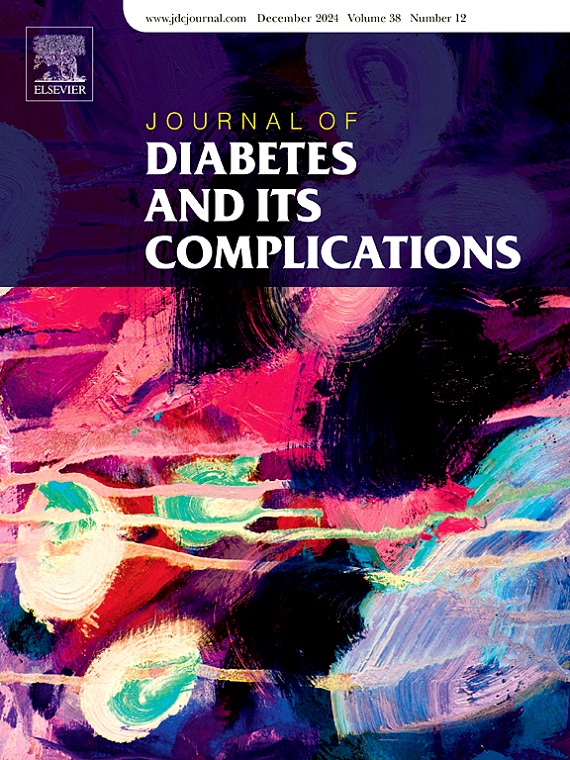正常蛋白尿糖尿病肾病的临床结局及危险因素
IF 3.1
3区 医学
Q3 ENDOCRINOLOGY & METABOLISM
引用次数: 0
摘要
背景:蛋白尿是糖尿病肾病(DKD)的关键预后指标,但一些患者在疾病进展过程中没有出现蛋白尿,这种情况被称为正常蛋白尿DKD。本研究旨在评估正常蛋白尿DKD的预后,并确定与进展相关的因素。方法共纳入24558例无基线蛋白尿的2型糖尿病患者。监测肾功能和蛋白尿。患者被分为两组:正常蛋白尿组(在估计肾小球滤过率[eGFR]降至30 mL/min/1.73 m2之前无蛋白尿)和突发蛋白尿组(在eGFR降至30以下之前出现蛋白尿)。肾脏疾病进展,定义为eGFR下降50%或终末期肾脏疾病,在倾向评分匹配后进行比较。结果匹配后,每组纳入6575例患者。中位随访为139个月(四分位数间距72-204;最长21年)。突发蛋白尿组的进展风险更高(校正风险比为2.39[2.05-2.79])。在蛋白尿正常的患者中,年龄较大、血糖控制不良、心血管合并症和利尿剂使用与高风险相关,而二甲双胍和他汀类药物具有保护作用。结论尽管正常蛋白尿通常预示着良好的预后,但部分患者仍存在风险,需要密切监测和个体化护理。本文章由计算机程序翻译,如有差异,请以英文原文为准。
Clinical outcomes of and risk factors for normoalbuminuric diabetic kidney disease
Background
Albuminuria is a key prognostic marker of diabetic kidney disease (DKD), but some patients experience disease progression without developing albuminuria, a condition referred to as normoalbuminuric DKD. This study aimed to evaluate the prognosis of normoalbuminuric DKD and identify factors associated with progression.
Methods
A total of 24,558 patients with type 2 diabetes and no baseline albuminuria were enrolled. Kidney function and albuminuria were monitored. Patients were classified into two groups: the normoalbuminuria group (no albuminuria until estimated glomerular filtration rate [eGFR] declined to 30 mL/min/1.73 m2) and the incident albuminuria group (albuminuria developed before eGFR declined below 30). Kidney disease progression, defined as >50 % eGFR decline or end-stage kidney disease, was compared after propensity score matching.
Results
After matching, 6575 patients included per group. Median follow-up was 139 months (interquartile range, 72–204; maximum, 21 years). The incident albuminuria group had a higher risk of progression (adjusted hazard ratio, 2.39 [2.05–2.79]). Among normoalbuminuric patients, older age, poor glycemic control, cardiovascular comorbidities, and diuretic use were linked to higher risk, while metformin, statins were protective.
Conclusions
Although normoalbuminuria generally indicates favorable prognosis, some patients remain at risk and require close monitoring and individualized care.
求助全文
通过发布文献求助,成功后即可免费获取论文全文。
去求助
来源期刊

Journal of diabetes and its complications
医学-内分泌学与代谢
CiteScore
5.90
自引率
3.30%
发文量
153
审稿时长
16 days
期刊介绍:
Journal of Diabetes and Its Complications (JDC) is a journal for health care practitioners and researchers, that publishes original research about the pathogenesis, diagnosis and management of diabetes mellitus and its complications. JDC also publishes articles on physiological and molecular aspects of glucose homeostasis.
The primary purpose of JDC is to act as a source of information usable by diabetes practitioners and researchers to increase their knowledge about mechanisms of diabetes and complications development, and promote better management of people with diabetes who are at risk for those complications.
Manuscripts submitted to JDC can report any aspect of basic, translational or clinical research as well as epidemiology. Topics can range broadly from early prediabetes to late-stage complicated diabetes. Topics relevant to basic/translational reports include pancreatic islet dysfunction and insulin resistance, altered adipose tissue function in diabetes, altered neuronal control of glucose homeostasis and mechanisms of drug action. Topics relevant to diabetic complications include diabetic retinopathy, neuropathy and nephropathy; peripheral vascular disease and coronary heart disease; gastrointestinal disorders, renal failure and impotence; and hypertension and hyperlipidemia.
 求助内容:
求助内容: 应助结果提醒方式:
应助结果提醒方式:


